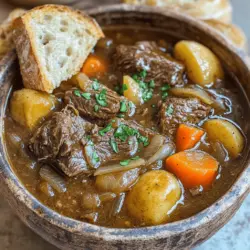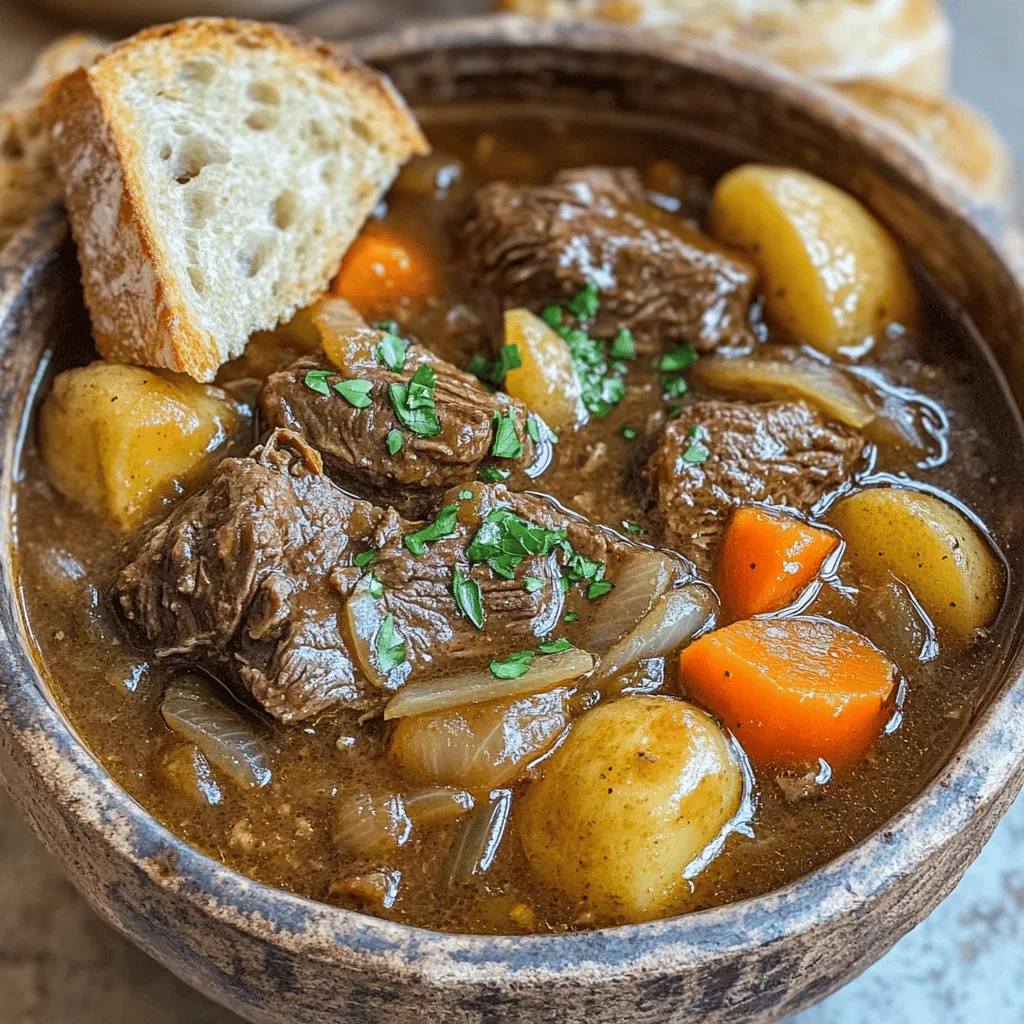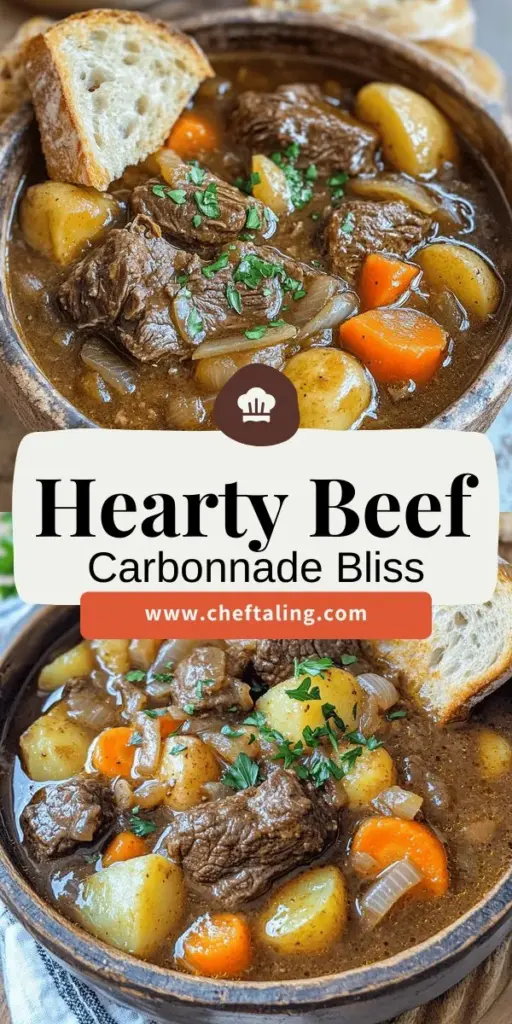Beef Carbonnade Stew is a rich, hearty dish that warms your soul. You’ll love how the deep flavors come together with simple ingredients. In this guide, I’ll share essential tips and step-by-step directions for making the perfect carbonnade. From choosing the right beef to serving suggestions, you’ll learn it all. Dive in and discover how to impress your family or guests with this delightful recipe!
What are the Essential Ingredients for Beef Carbonnade Stew?
Beef carbonnade stew is rich and filling. The main part of this dish is the beef. I recommend using beef chuck. It has the right fat content and flavor. Cut it into 2-inch cubes to ensure even cooking.
Besides beef, onions play a key role. Use three large onions, thinly sliced. They add sweetness and depth when caramelized. Garlic is also a must. Four cloves, minced, bring a fragrant touch that enhances the stew.
You will need beef broth for a rich base. Three cups of broth will provide depth. Apple cider vinegar adds a hint of tang. This balances the stew’s flavors. Brown sugar brings a touch of sweetness. It helps to round out the taste.
Dijon mustard is another important ingredient. Just one tablespoon adds a nice kick. Use bay leaves and dried thyme for herbs. These give the stew a warm, comforting flavor. Don’t forget to season with salt and pepper.
For added nutrition and flavor, include carrots and potatoes. Four large carrots, chopped into chunks, add color and sweetness. Four medium potatoes, cut into pieces, make the stew hearty.
Finally, fresh parsley is a great garnish. It adds a pop of color to your dish. For a full step-by-step guide, check the Full Recipe for beef carbonnade stew.
How Do You Make Beef Carbonnade Stew Step by Step?
To make beef carbonnade, you follow some simple steps. First, you need to gather all your ingredients. You will start with beef chuck, onions, garlic, broth, and a few seasonings. You can find the full recipe for more details.
What is the Cooking Process for Carbonnade?
You begin by heating olive oil in a heavy pot. Once the oil is hot, add the beef cubes. Brown them on all sides. This step adds great flavor. After browning, set the beef aside. In the same pot, add the sliced onions. Cook them for about eight minutes. Stir them often until they are soft and caramelized. Then, add minced garlic and let it cook for one more minute.
Next, return the beef to the pot. Pour in the beef broth and add apple cider vinegar, brown sugar, Dijon mustard, bay leaves, and thyme. Make sure to stir everything well. Season with salt and pepper. Bring it all to a gentle boil, then cover the pot and lower the heat. This is where the magic happens.
How Long Should the Stew Simmer?
Let the stew simmer for one and a half hours. Stir it occasionally to keep it from sticking. After this time, add the chopped carrots and potatoes. Stir gently and continue to simmer. You should let it cook for another 30 to 40 minutes. The goal is to have tender vegetables and fork-tender beef.
What Tips Ensure Perfect Cooking?
For the best result, use a heavy pot. This helps with even cooking. Make sure not to rush the simmering process. This slow cooking lets the flavors blend well. Always taste your stew before serving. Adjust the seasoning if needed. And remember to remove the bay leaves before serving. Garnish with fresh parsley for a nice touch. Enjoy your hearty meal!
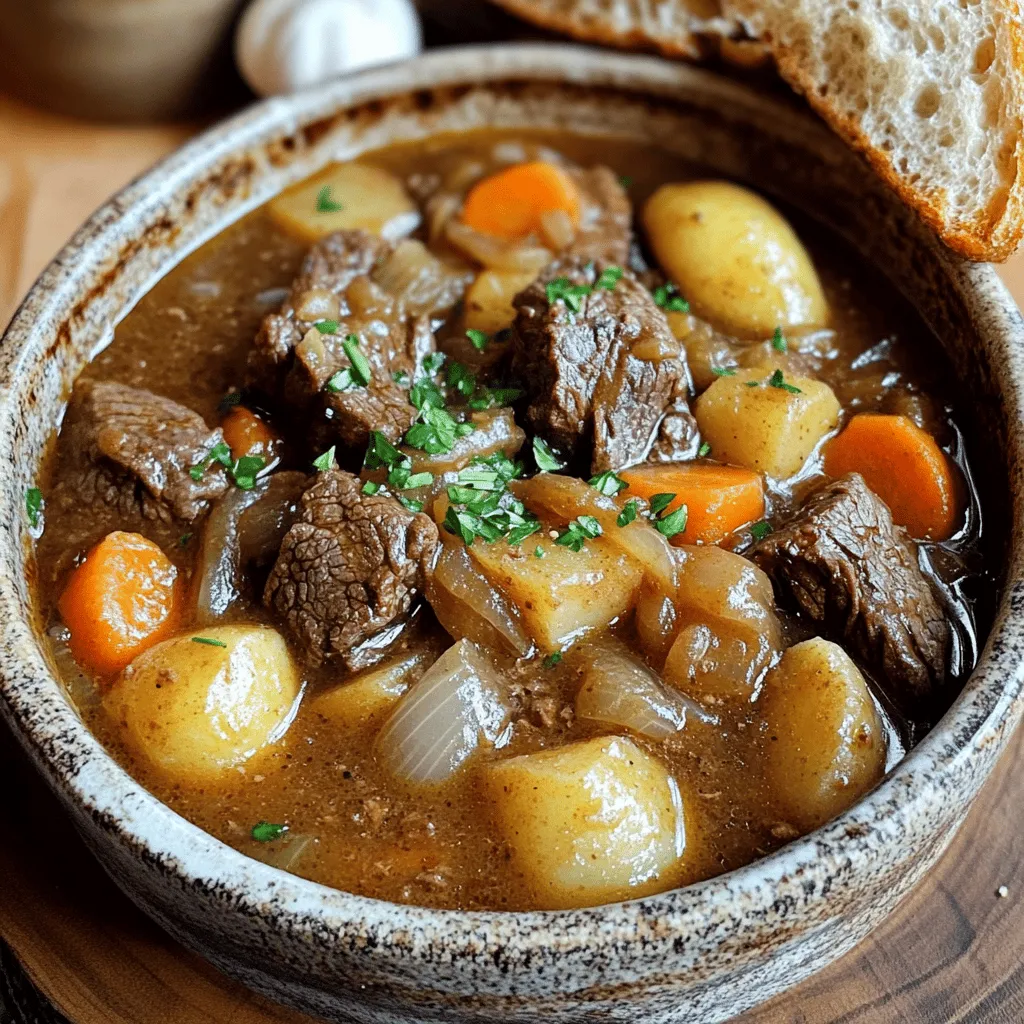
What Variations of Carbonnade Can You Try?
You can explore many variations of carbonnade to suit your taste.
How Can You Make Carbonnade with Beer?
Beer adds a rich flavor to carbonnade. You can use a dark beer like stout or ale. Replace some beef broth with beer in your recipe. This will deepen the stew’s taste. The alcohol cooks off, leaving the flavor behind.
What Are Unique Twists on the Traditional Recipe?
You can try adding fruits like prunes or apples for sweetness. This twist brings a new layer of taste. Some add mushrooms for an earthy flavor. Others use different meats, like pork or lamb. Each change creates a unique dish. You can also experiment with spices. Try adding cinnamon or cloves for warmth.
How Can Dietary Needs Be Met in Carbonnade Preparations?
For gluten-free options, use gluten-free beer or broth. This keeps the stew tasty for all. If you want a lighter version, use chicken or turkey. You can also add more vegetables to reduce meat. Swap potatoes for sweet potatoes for a twist. This recipe is easy to adjust for different diets.
Feel free to check the Full Recipe for more details. Cooking carbonnade can be fun and creative!
What Cooking Techniques Should You Use for Beef Stew?
Braising is key to making beef carbonnade stew. This method combines cooking meat slowly with moisture. It helps break down tough beef and makes it tender. You start by browning the beef. This adds flavor and color. Then, you cook it in liquid for a long time. The result? A rich and hearty stew.
What Is the Importance of Braising in Stews?
Braising is crucial for flavor and texture. It helps meld the ingredients together. The beef absorbs the broth and spices. This deepens the taste. It also allows the meat to become very soft. You want your beef to fall apart with a fork. Braising achieves this perfectly.
How Can You Avoid Common Mistakes?
One common mistake is not browning the beef enough. This step builds flavor. Another mistake is cooking at too high a temperature. Slow cooking is essential. It helps the beef become tender. Always check the seasoning as well. You can add salt and pepper throughout cooking. This ensures balanced flavor.
What Equipment Is Recommended for Cooking Carbonnade?
A heavy pot, like a Dutch oven, is best for carbonnade. It holds heat evenly and is great for browning. A wooden spoon helps stir without scratching the pot. You may also need a sharp knife to chop the vegetables. Lastly, use a ladle for serving the stew. This makes it easy to dish out portions.
If you want to try this dish, check out the Full Recipe. Enjoy the journey of cooking and savoring this delightful meal!
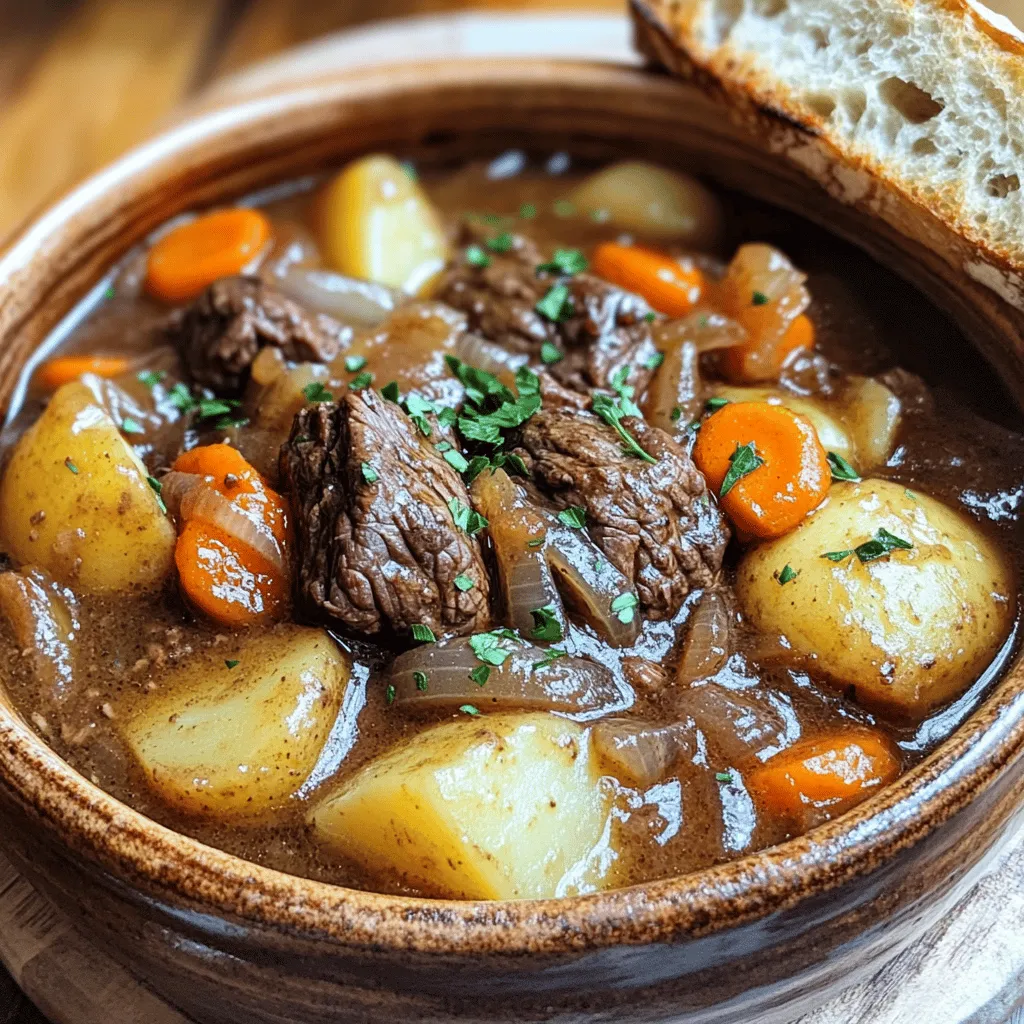
What Are the Best Serving Suggestions for Carbonnade?
When serving beef carbonnade, think comfort and warmth. This dish shines with simple yet tasty sides.
What Sides Pair Well with Beef Carbonnade?
I love to serve carbonnade with crusty bread. The bread soaks up the rich sauce. Mashed potatoes also work well. They add creaminess to the meal. Roasted vegetables bring color and flavor. Try carrots, Brussels sprouts, or green beans. A fresh salad provides a crisp contrast. This mix of sides makes a well-rounded meal.
How Can You Present Carbonnade at Dinner Parties?
For dinner parties, presentation matters. Use deep bowls to serve the stew. Ladle it generously, showcasing the beef and veggies. Garnish with chopped parsley to add a fresh touch. Pair with a nice loaf of bread on the side. You can also add a cheese platter to impress your guests. This simple setup looks elegant and inviting.
What Wines Complement the Flavor of Carbonnade?
Wine can enhance the meal. A rich red wine works best. Look for a Merlot or Cabernet Sauvignon. These wines balance the stew’s flavors. A Belgian ale is another good option. It pairs nicely with the dish’s hearty nature. Offer your guests a choice for a fun dining experience.
What is the History and Cultural Significance of Carbonnade?
Carbonnade has deep roots in Belgian cuisine. This dish has warmed hearts for centuries. People believe it comes from the Walloon region. The name “carbonnade” comes from “carbon,” referring to charcoal. It reflects the cooking method on an open flame.
Over time, cooks have made their own versions. Each chef adds personal touches. They might use different meats, spices, or even beer. This flexibility helps carbonnade stay popular. It brings families together around the table.
In Belgium, you find many regional variations. In Flanders, cooks often use beer to give flavor. This adds a rich taste and depth. In Wallonia, the dish may feature more herbs and local veggies. Each place has its own style, but the heart remains the same.
When you make carbonnade, you tap into history. You honor traditions while creating a meal for today. The full recipe shows how to blend these flavors. Enjoy exploring this classic dish in your own kitchen.
Beef carbonnade stew combines rich flavors and tradition. You learned about the best beef cuts, key ingredients, and cooking methods. I shared tips to avoid mistakes and enhance taste. Exploring variations opens up more options too.
Remember, whether you stick to the classic or try something new, carbonnade is versatile. Enjoy the process and share your delicious results. Happy cooking!
